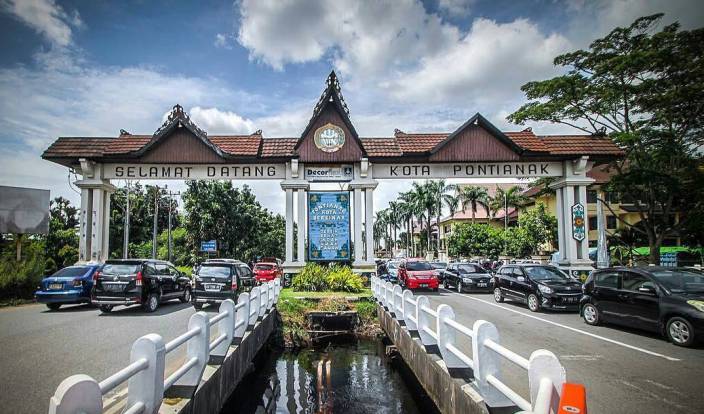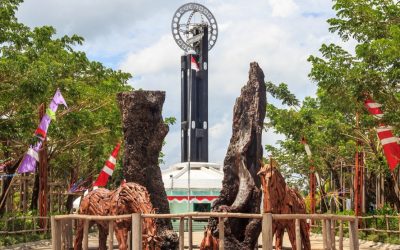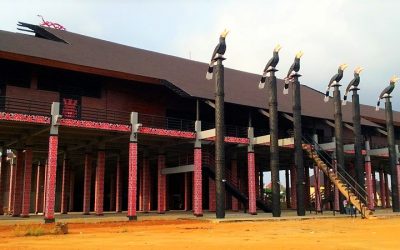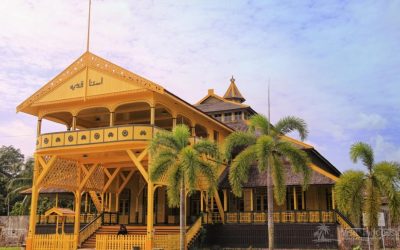Home / Batik Regions – Central Indonesia – Kalimantan Island – West Kalimantan / Pontianak City
Cultural Destination
Embrace the spirit of the place!
Pontianak City
The Gate of Pontianak City (photo: HelloPontinesia)
Pontianak City
It is the capital city of West Kalimantan, also known as the “Equator Zero”. There are a lot of things that tourists can do in this city, like hiking, visiting the Equator Monument, Baning Forest tourism site, and tasting excellent local dishes. This city is inhabited by three different ethnicities with distinctive cultures, namely Dayak, Malay, and Chinese descendant communities that have blended together over the centuries. Such cultural blends could be seen in its architecture, textile, and gastronomic heritages.
Tourist Attractions in West Kalimantan
Equator Monument
As the main tower in Pontianak, the equatorial monument is crossed by a line that divides the
Betang Traditional House
The Betang house is the traditional Dayak Great House, and it contains a lot of its spiritual and
Kadriah Royal Palace
This is the place if you want to see cultural assimilation through architecture. Located in East Pontianak,
West Kalimantan
Batik Motifs
Dayak Kamang
Kamang motif is generally found in the Dayak tribe shield because it is believed to
Insang Ikan
Insang refers to the gills of the fish. This is a typical pattern of Malay ethnic who inhabits
Awan Berarak
Awan Berarak is a combination of Dayak motifs and Malay patterns. The word ‘Awan Berarak’ means the
Discover
Indonesian
Batik
Motifs
Lok Baintan Floating Market
As you can imagine, the most authentic thing is that you can buy things and even
Bekantan Pakis
This motif represents Pakis Haji (Polystichum setiferum), an endemic plant in
Durian Pecah
Broken Durian motifs depict the foundation of faith. The second half signifies the mastery of
Tikar Natuna
The Tikar Natuna motif is adapted from the traditional making of pandanus mats in
Rumah Mamuju
the Batik motif illustrates the house of Mamuju King with the stairs, located on the left of the wooden stage house
Gonggong Siput
Gonggong (Strombus Turturella) is one type of sea snail found around
Karawo Mahkuta
Mahkuta refers to Gorontalo’s traditional crown. It represents noble characters of
Tanah Liek
The word “Tanah Liek” refers to clay in Minang language. It is also known as
Pattimura
Pattimura is the name of an Indonesian hero who fought against colonialism in
Enggang Dayak
Local people beliefs that hornbills are an incarnation of the Commander of the Birds. It has supernatural
Rangkiang
The word “Rangkiang” refers to the rice granary in the Minangkabau language. It symbolizes
Hiu Taliyasan
Indonesia is also home to the world’s largest fish, the whale shark (Rhincodon typus). Hiu Taliyasan refers to
Tabir Tanjung
Tanjung flower is a type of Cherry tree flower, which is commonly found in
Prada Papua
The word “Prada” in the Javanese-Indonesian dialect means a batik textile that
Sido Mulyo
Sidomulyo is one of the classical motifs, which is specifically used for the bride’s costume in
Sekomandi
Its philosophical meaning is the eternal union which refers to a saying “until death do us part”
Kuda Kupang
Horses symbolize wealth. It contains noble values of virtuous characters that bring
Gorga Simeol-Meol
The Gorga Simeol-meol is a pattern of plant tendrils. it is regarded as a symbol of longevity and
Besurek Rafflesia
The term “Basurek” refers to a textile that contains letters or inscriptions
Keluak Daun Pakis
The word “Keluak” is a Minang language which means twisted or tangled. The Motif of
Kain Cual
Cual textile tradition has existed since the 17th century. The word “Cual” refers to
Kaganga Tanah Rejang
If Batik Besurek combines Arabic calligraphy motifs, then the Kaganga batik takes
Sandeq
Sandeq Boat is a symbol of the maritime importance of the West Sulawesi region. The greatness of
Burung Bidadari
Bidadari birds are endemic birds in Halmahera. This motif represents an
Bale Lumbu
This motif signifies the welfare of the ancient Sasak society. Bale also symbolizes the
Tifa Totobuang
The batik motifs illustrate Maluku’s traditional music instrument called
Parang Rusak
Another meaning behind this motif is an unconquerable spirit, symbolized by
Sekar Jati
Sekar means flower and Jati refers to teak trees that symbolizes a strong mental character that
Teguh Bersatu
This batik motif shows the strength of the people of Kupang. It also represents a sense of
Raja Ampat
Raja Ampat motif represents the marine life at Raja Ampat archipelago in
Sero Tangga
The Sero Tangga illustrates an endearing feeling and sacrifices of a person to fulfil
Bultiya
The word ‘Bultiya’ is an acronym of the three major tribes in North Kalimantan, namely
Tubo Kelapa
Coconut tree is a symbol of a good character and strong mentality. It illustrates the more success a person, the more
Pucuk Rebung Riau
Pucuk Rebung symbolizes heart determination in achieving goals, good luck, and
Bomba Mawar
This motif means sacred love for family, kingdom, and God; It also illustrates
Wirasat
Wirasat or divine inspiration is a gift from God. This inspiration is symbolized by
Bintik Tujuh
The Bintik Tujuh (Seven Dots) motif has 7 white spots and green color gradation as
Pala Salawaku
This motif illustrates the unique weapons of the Maluku region, namely
Kawung
The Kawung motif was created by Sultan Agung Hanyokrokusumo (1593 – 1645) as a symbolic gift for
Daun Simpor
This motif is inspired by the Simpor plant (Dillenia Suffruticosa) which is a typical
Mahkota Siger
Siger is the crown of a noblewoman in ancient time. It is a symbol of femininity, strength, and
Gurdo Solo
Gurdo or garuda bird is the mount of the Indian god Vishnu. As the Sun Bird,
Gumin Tambun
Based on Hindu mythology, this motif symbolizes lucks, abundant wealth, and
Dayak Taghol
Dayak Taghol has a distinctive style of four curved lines and small dots. This motif represents
Gonggong Beruntun
This motif illustrates that a person should maintain a positive attitude and
Biji Kopi
The coffee seeds motif illustrates the pride of local coffee specialities in
Lontara
The Lontara script itself is a typical ancient script of Bugis and Makassar communities. History records that
Manguni Minahasa
Manguni is identified as the symbol of the Minahasa people. Manguni is known as a
Paqbarre Allo
The word “Barre” means round and “Allo” means the sunlight. This motif is interpreted as
Karawo Pinang
Pinang refers to the Palm areca tree. This motif is considered as the original
Ake Patra
Ake is related to the divinity and the composition of the universe. It is a symbol of
Wakatobi
It symbolizes the coastal beauty of the Wakatobi island and the symbol of Patra symbolizes
Awan Berarak
Awan Berarak is a combination of Dayak motifs and Malay patterns. The word ‘Awan Berarak’ means the
Besurek Rembulan
This batik illustrates praise for God who created the wonderful universe
Gamolan
This motif illustrates Gamolan, a bamboo musical instrument of Lampung that is
Salakanagara
Salakanagara batik motif illustrates the first kingdom in the Betawi land
Parang Seling
Parang Seling or “alternating daggers” is a royal batik motif. It is a feminine variant of
Jumputan Bintang
The word Jumputan means the tie-dye technique, while the word “Bintang” refers to
Singayaksa
The Singayaksa motif comes from the name of a place where Sultan Hasanuddin used to
Tenun Bima
The motifs are adopted from Bima woven textile. This pattern has received a great
Tampuk Manggis Sasirangan
The motif illustrates the philosophy of the mangosteen fruit, which is
Kaharingan
The Kaharingan or ‘tree of life’ based on the Dayak tribes’ belief system. This tree symbolizes
Taiganja
Taiganja is a precious gold pendant that shows the social status of the Kaili family. It is
Dayak Kamang
Kamang motif is generally found in the Dayak tribe shield because it is believed to
Kerawang Tegak Aceh
The Vertical Upright (Kerawang Tegak) Motif symbolizes a person who has a strong
Daun Lada Hitam
The black pepper motif represents the main commodity of Bangka Belitung
Ukir Sentani
The Ukir motif is a batik motif that is inspired by various traditional Sentani wood carvings
Angsa Duo
According to legend, the Angso duo batik motif is a pair of swans that are believed to have led Princess
Insang Ikan
Insang refers to the gills of the fish. This is a typical pattern of Malay ethnic who inhabits
Jupri Kembang Teh
Kembang Teh illustrates the tendrils of tea plants that grow in the highlands of
Srimanganti
The name of the Srimanganti motif is derived from Palace’s hallway that connects to
Tongkonan
Toraja’s traditional house is called Tongkonan. Tongkonan is a place for




